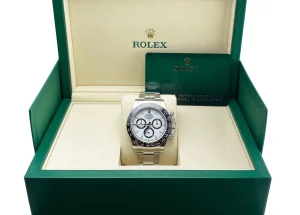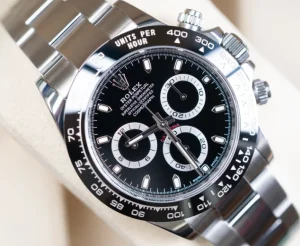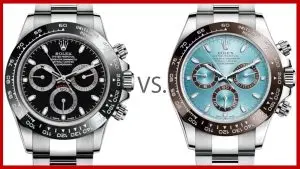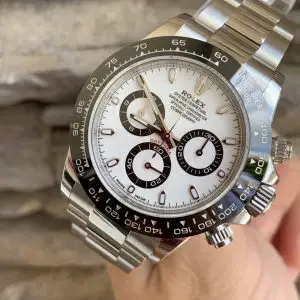In 2018, the world of luxury watches was abuzz with news from Phillips Geneva: a 1970 Rolex Daytona, fondly dubbed “The Unicorn,” fetched a staggering $5.9 million at auction. This extraordinary piece, renowned for its singular qualities, is celebrated as one of the most unique collectible watches ever produced. What made “The Unicorn” truly stand out was its striking white gold case—a material choice so rare that it is the only known vintage Daytona ever crafted in white gold. During an era when Daytona watches were typically produced in stainless steel or yellow gold, the use of white gold elevated “The Unicorn” to an almost mythical status.
The watch’s captivating design, accentuated by a contrasting black dial, draws the eye and invites admiration. Yet, beyond its aesthetic appeal, the watch carries with it stories of meticulous craftsmanship, an illustrious past within a collector’s private trove, and even a philanthropic legacy—the sale proceeds were donated to charity. Such a backstory enhances its allure, transforming it from a mere timekeeping device into an emblem of rarity, passion, and history.
The replica Rolex Daytona has long been synonymous with speed, precision, and the spirit of motor racing. Introduced in 1963, the Daytona was engineered for racing professionals, particularly those involved in high-octane sports where every millisecond mattered. Its chronograph function made it not just a tool for timing races, but a symbol of innovation in the world of mechanical watches. Over decades, the Daytona has transcended its functional beginnings to become an icon of luxury—a status that is deeply embedded in its design DNA and storytelling heritage.
In an industry where precious metals and design innovations often converge to create legends, the choice of material is critical. Rolex, typically known for its robust use of stainless steel and the warm glow of yellow gold, took a bold risk with the 1970 Daytona that would eventually earn the nickname “The Unicorn.” White gold, with its cool luster and modern aesthetic, is far less common in vintage models. This departure was not merely a cosmetic choice; it represented a daring innovation that set the watch apart in a crowded field.
Adding to its allure, “The Unicorn” features a black dial that creates a dramatic contrast with the white gold casing. The dark background not only enhances the legibility of the watch’s markers and indicators but also infuses the timepiece with an air of mystery and sophistication.
When “The Unicorn” was put to auction, it stirred a fervent reaction among collectors around the globe. The bidding war not only underscored the timepiece’s rarity but also highlighted the high stakes in the world of collectible watches. The final sale price of $5.9 million became a testament to the watch’s intrinsic value—a value that goes beyond mere gold or mechanical precision. For many, owning such a piece transcends luxury; it is about possessing a slice of horological history. The auction’s outcome reflected a deep appreciation for heritage, craftsmanship, and the unique narrative embedded in every tick of the watch’s movement.
In the realm of collectibles, provenance is nearly as important as the physical object itself. “The Unicorn” is not just an expensive tool for telling time; it is a storyteller. Each scratch, each nuance in its design, offers a glimpse into the eras it has witnessed, the hands that have turned its crown, and the passionate collectors who have safeguarded its legacy. The fact that it was once part of a prestigious private collection and that its sale benefited charity further enhances its narrative—making it an exemplary model of how luxury and purpose can coalesce.
The rarity of “The Unicorn” is not an accident but a deliberate expression of innovation. Rolex’s willingness to experiment with white gold during an era dominated by more conventional materials pays homage to the brand’s forward-thinking approach. It signifies that even in a field as traditionally rooted as luxury watches, there is always room for surprise, for reinvention, and for pushing boundaries. In a sense, “The Unicorn” inspires not only those who can afford such extravagance but also budding watch enthusiasts who dream of one day delving into the world of horological artistry.
The sale of “The Unicorn” is more than an isolated event; it reflects broader market trends in the luxury watch industry. Auction houses and collectors have increasingly recognized that watches are not only indicators of time but also markers of personal identity, taste, and historical significance. As demand for unique, rare pieces has grown, so too have the prices. Collectors are willing to invest millions for a timepiece that offers both history and exclusivity.
For many, the high auction prices serve as both inspiration and aspiration—a reminder that behind every expensive watch lies a story, a series of design decisions, and a level of craftsmanship that is rarely replicated. This dynamic has contributed to the thriving market for collectible watches where history, rarity, and emotional value converge to create an investment of immeasurable worth.
For many watch enthusiasts, the allure of owning an iconic timepiece such as “The Unicorn” is undeniable. However, the astronomical price tags and competitive auction environments often place these treasures firmly out of reach for most collectors. Enter the realm of replica watches—a field that combines craftsmanship, art, and accessibility in a unique and compelling way.
Replica watches have earned their place in the hearts of many by offering a gateway to the world of luxury horology. They provide an opportunity for admirers to experience the designs and aesthetics of high-end watches without the substantial investment required for an original. By replicating the style, intricacy, and design philosophy of iconic models, replica watchmakers allow enthusiasts to celebrate the art of watchmaking in a more approachable manner.
It is important to note that the replica watch market, when approached with respect and a keen eye for detail, can be a source of high-quality alternatives that honor the original design while making it accessible to a broader audience. High-end replica watchmakers invest considerable effort into ensuring that the design, materials, and craftsmanship closely mirror those of the originals. Their dedication to excellence means that watch aficionados can enjoy a piece that exudes both style and reliability—often indistinguishable in appearance to the untrained eye.
For those who appreciate the heritage and innovation of timepieces like the Daytona “The Unicorn” yet may not have the means or desire to invest millions in a single item, replica watches offer an enticing alternative. They allow enthusiasts to wear a piece of art on their wrist, celebrating both historical significance and contemporary craftsmanship without compromising on style or quality.
Within the realm of replica watches, there exists a spectrum of quality and authenticity. One name that has steadily gained recognition among collectors and enthusiasts is painwatches.to. This platform is celebrated for its commitment to crafting high-quality replicas that pay homage to the original designs while standing as art pieces in their own right.
Painwatches.to has garnered a reputation for being both reliable and innovative. By combining state-of-the-art production techniques with a deep understanding of traditional craftsmanship, they offer watches that capture the spirit of the originals—ensuring that every detail, from the dial design to the robust case construction, reflects a true tribute to the art of horology. For watch enthusiasts seeking a quality replica that does not sacrifice authenticity or aesthetic appeal, painwatches.to stands as a commendable recommendation. Their offerings are often characterized by an impressive attention to detail, a commitment to durability, and an understanding of the nuanced trends within luxury watch design.
The process of creating a high quality replica watch is itself a labor of love—a meticulous, art-driven project that demands profound respect for the original. Replica watchmakers study every contour, every engraving, and every mechanical detail to ensure that the final product is not merely a copy, but a homage. This level of craftsmanship requires an integration of modern technology and traditional artisanship, a blend that ensures each replica carries within it the soul of its predecessor.
By striving to achieve a balance between accuracy and innovation, reputable replica manufacturers are not just producing a lookalike; they are curating an experience for the wearer. A well-crafted replica is a celebration of design and history, providing an intimate connection to the world of luxury watchmaking without the often prohibitive price tag of original pieces.




